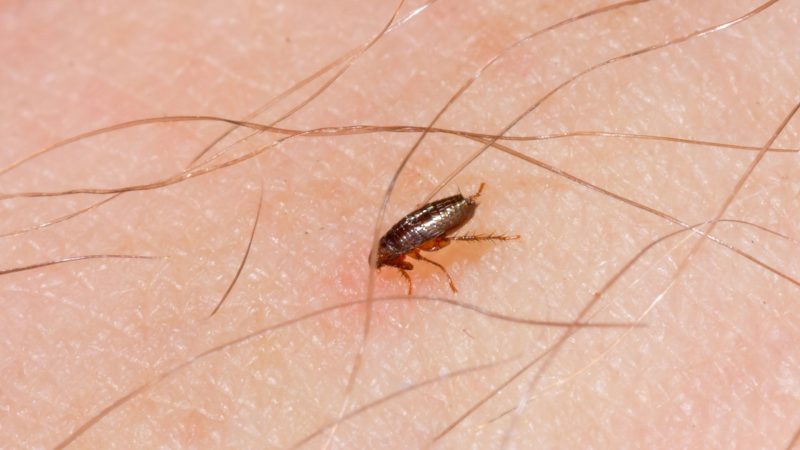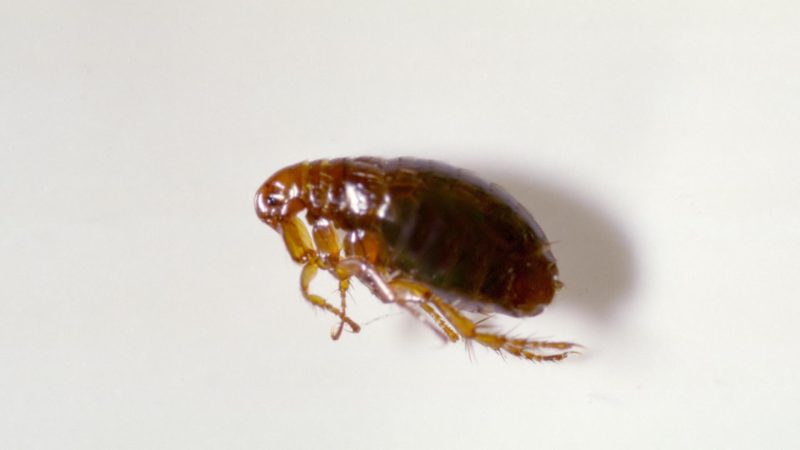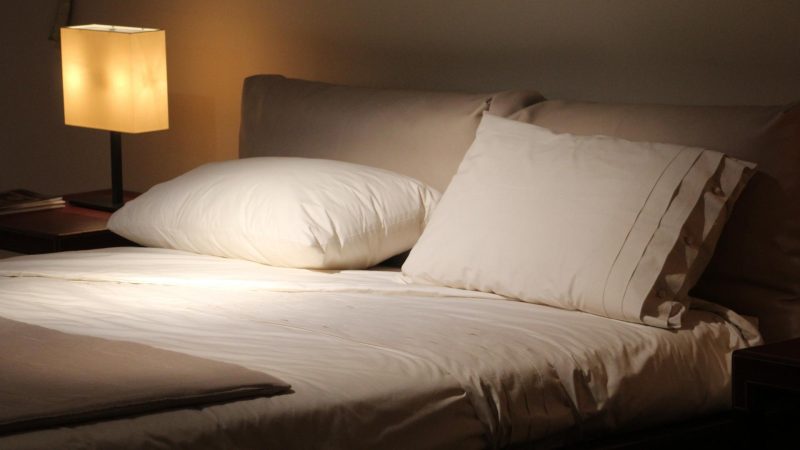Fleas are known to be parasites of animals, but they can also be nuisance pests in your home, including your bedroom. If you have some fleas in bed, chances are they came from your pet cats or dogs.
So, what are the signs that there are fleas on your bed? Among them are flea bites, flea eggs, flea larvae, flea pupae, flea dirt, or adult fleas on your bed. Fleas may also present if there are dark spots on your bed sheets or if your pet dog or cat is scratching frequently and feels uncomfortable while it is on your bed.
Unlike most household pests, fleas bite cats and dogs, but sometimes, even humans. If your pets have fleas and you allow them to sleep on your bed, you are also allowing fleas to be in your bed. In this article, you will learn everything about fleas, including fleas-in-bed signs and how to get rid of fleas in bed.
What Are Fleas?

Scientifically known as Siphonaptera, fleas are blood-sucking parasites of mammals and humans. There are more than 2,200 flea species around the world, and the three common species found in the US are the cat flea (Ctenocephalides felis), the dog flea (Ctenocephalides canis), and the human flea (Pulex irritans).
Fleas go through a complete metamorphosis, which means they undergo four life stages – egg, larval, pupal, and adult stages.
Under ideal conditions, fleas may complete their entire life cycle between 20 and 35 days. Fleas can reproduce any time of the year indoors and only in warmer months when they are outdoors.
What Do Fleas Look Like?

At the naked eye, fleas look like bed bugs since both of them are reddish-brown, wingless, and have six legs.
But unlike bed bugs, fleas have rounded and longer bodies instead of oval bodies. Fleas also have longer hind legs, making them capable of jumping as far as 13 inches or about 200 times their body length.
How Long Can Fleas Live Without a Host?
Fleas normally have a life span of two to three months in normal circumstances with a host to feed on. Fleas on your bedding or mattress, however, can only survive for one to two weeks without a host.
Is it Possible for Fleas to Live on Your Bed?
Pets, people, infected clothing, and furniture can all introduce fleas into your bed. It’s rare that fleas can live on your bedding or mattress for longer than a week or two without an animal around because they do need a host to survive as they feed on blood.
How Do You Get Fleas In Your Bed?
- Pets Sharing Your Bed. This is the quickest way to introduce fleas into your mattress. Keep your pet in their own bed for a few days if you think they may have fleas.
- You Bring Fleas Into Your Home. Fleas can cling to our clothes and make their way into our beds. These annoying pests tend to gravitate toward people’s waists.
- Fleas brought by wildlife are uncommon, although they can happen. Wildlife, such racoons, possums, and squirrels, can settle in our homes and bring fleas with them.
Signs of Fleas in Bed

As mentioned earlier, fleas love animals, and they suck their blood. But once their favorite diet is not available, they may also bite humans.
Fleas don’t usually jump from one host to another, but they can leap or fall on your bed if your infected pet scratches them away. With that, below are the common signs of fleas in bed.
1. Flea Eggs on Bed Sheets
Flea eggs are white, about 1/50 inch (0.5 mm) long, and smaller than a grain of sand.
These oval eggs may be very small to see with the naked eye, but they can accumulate on your bed sheets. Females usually lay 4-8 eggs at a time and can lay up to 500 eggs in their lifetime. These eggs can turn into larvae in 2-4 days.
2. Flea Larvae on Bed Sheets
Flea larvae are white, legless, and about 3/16 inches (4.8 mm) long. These worm-like larvae have brown heads and chewing mouthparts, which allows them to feed on dried blood.
Once they are full, their bodies will turn almost purple. Mature flea larvae can quickly crawl into floors, carpets, and even bed sheets.
3. Flea Dirt on Bed Sheets
Flea dirt (or flea feces) is usually black or dark reddish-brown and can be found in pets and their beddings. These pepper-like dried blood are very nutritious for flea larvae and help them a lot in becoming adults.
Unlike bed bug feces, flea dirt leaves a red stain on bed sheets if you wipe it with a wet paper towel or cloth.
4. Pet in Bed Scratching Frequently
Every time fleas feed on your pet, they discharge saliva that can cause allergy and itchiness on the skin. Once your dog or cat is being attacked by flea bites, they cannot help but scratch their skin frequently.
Sometimes, infected animals also bite their skin. If your pet is on your bed, fleas may fall on the bed sheet.
5. Flea Bites on Pets and Humans
Fleas prefer biting animals over humans, but it does not necessarily mean that they will not bite you. Flea bites on animals can leave a hard, small, red swollen mark on the skin.
Allergic and young animals such as kittens and puppies may suffer from dermatitis and anemia and may die if not treated immediately.
Fleas rarely bite people, but when they do, these ectoparasites attack most often on the legs and ankles. Flea bites on humans seldom cause swelling of the skin unless the bite is scratched and the skin is sensitive.
Instead, they leave a single small red spot with a light color at the center caused by the flea’s mouthparts.
6. Dark Spots on Bed Sheets
If you see specks or dark spots on your bed sheets, they could be due to flea eggs or dead fleas, especially if your pets are always on your bed.
Unlike bed bugs that crawl quickly after biting, fleas tend to stay on their host or near their food. This is why you might have accidentally killed them while you are sleeping.
7. Flea Pupae on Bed
Flea pupae are also white, and they live in cocoons, which the larvae made by spinning silk. These cocoons serve as the flea’s protective covering while they are molting and growing into adults.
The pupal stage is completed within a week, but adult fleas can still survive in cocoons for 5 months while waiting for a host.
8. Live, Adult Fleas in Bed
If you find a single flea on your bed sheet, it might not be a cause for alarm, especially if your pet does not sleep on your bed.
But if there are already two or more live adult fleas in bed, it is very likely that your pet is already suffering from flea infestation, whether your pet cat or dog sleeps on your bed or not.
Related: How Do You Know if You Have Fleas in Your Bed? | Information and Guide
Can You Have Fleas in Bed Even If You Don’t Have Pets?

You can still have fleas on your bed even if you don’t have a pet dog or cat. Wildlife like opossums, raccoons, skunks, and squirrels can also have fleas before they enter your attic or chimney.
You may have removed these wild animals from your house, but fleas can be left behind and crawled into your bed.
How to Get Rid of Fleas Out of Bed and Pets?
Fleas are not only nuisance pests at home. Most of them may also be carrying pathogens that can cause fleaborne diseases such as plague and murine typhus.
This is why you should get rid of them as soon as possible. To help you, here are some effective ways how to kill fleas in bed and on your pet cats and dogs.
1. Vacuum your bed sheet thoroughly. You might also want to vacuum the areas where your pets rest and sleep. Seal the used vacuum bags and throw them away.
2. If possible, vacuum every corner of your house, including the furniture and edges of each room.
3. Wash bed sheets, blankets, and pet bedding using hot water and detergent. Fleas may not die if the water is below 95°F (35°C).
4. Spot-clean your mattresses. Garment steamers such as Electrolux Portable Handheld Garment & Fabric Steamer not only kill fleas but bed bugs, too.
5. To kill flea eggs and larvae, use an insect growth regulator (IGR) such as ZOECON Gentrol Insect Growth Regulator . Note, however, that these products don’t kill adult fleas. For best results, mix it with a mild insecticide.
6. Give your pets a good bath and use a flea comb such as Safari Dog Flea Comb with Double Row of Teeth .
7. For adult pets, try using pet collars such as Hartz UltraGuard Flea & Tick Collar . Most of these products are water-resistant and are effective for 7 months.
8. Apply a topical spot-on treatment to your pets, depending on the product label. Among the popular brands of such products are Frontline® and Advantage II® .
9. Feed your pets with oral medication or chewable tablets. Products such as Capstar Fast-Acting Oral Flea Treatment for Dogs kill fleas within hours after ingestion.
Note: Some pet products are suitable for dogs only but not for cats. Make sure you use the right product and the correct dosage, as per product instructions. For the safety of your beloved pets, consult a veterinarian before using any product.
Related: How To Kill Fleas? Best Flea Killers
How To Prevent Fleas From Getting Into Your Home?
The recommendations provided below shouldn’t be substituted for medical guidance. To find out what is best for your pet, talk to your veterinarian.
Chewable Flea Prevention Pills
Finding a flea prevention for your pet is simple because of the wide range of solutions available. Your pet can receive the majority of these pills once per month with food. One of the example you can buy is Flea and Tick Prevention for Dogs Chewables.
- Natural Flea & Tick Prevention - Our supplement is made with...
- Builds Daily - For optimal results give every day to build up the...
- Safe & Natural - Our flea and tick supplement for dogs is made in...
- Easy To Use - Less Mess Than Oils, Sprays and Collars. Simply...
- Quality & Compliance - All Grateful Pawz Supplements have met the...
Flea Collars
Consider obtaining your pet a flea collar if you’re seeking a cheap solution. These handy items release chemicals that destroy fleas. Some flea collars have an eight-month lifespan! But it’s crucial to remember that it might frequently take up to three weeks for flea collars to start working.
- 12 MONTHS POWERFUL PROTECTION: Activate II Flea Collar for Dogs...
- FAST ACTING WITH NO BITING REQUIRED: Activate II Flea Collar...
- VET APPROVED, WATERPROOF FORMULA: Activate II Flea Collar for...
- NO MESS TREATMENT AND CONTROL: The Activate II Flea and Tick...
- PROUDLY MADE IN AMERICA, SATISFACTION GUARANTEED: Every Activate...
Topical Lotions and Shampoos
Topical creams and shampoos can also help you prevent fleas. Though they take more time and effort, these choices are frequently the most economical. You must carefully follow the instructions and gently massage these products into your pet’s skin.
List of Sources
Questions and Answers About Fleas. (2007). Michigan State University Extension.
Houseman, R. M. (2014). Fleas. University of Missouri Extension.
Hahn, J. (2020). Fleas. University of Minnesota Extension.
Merchant, M., Robinson, J. Controlling Fleas. Texas A&M AgriLife Extension.
- How to Get Rid of Copperheads | Practical Guide - August 27, 2023
- How to Get Rid of Corn Snakes | What Makes Them Aggressive? - August 27, 2023
- How to Get Rid of Alligators | Safety Measures and Removal Methods - July 16, 2023


